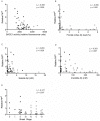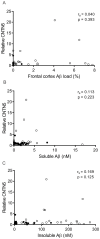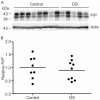Prion protein is decreased in Alzheimer's brain and inversely correlates with BACE1 activity, amyloid-β levels and Braak stage
- PMID: 23577068
- PMCID: PMC3618446
- DOI: 10.1371/journal.pone.0059554
Prion protein is decreased in Alzheimer's brain and inversely correlates with BACE1 activity, amyloid-β levels and Braak stage
Abstract
The cellular prion protein (PrP(C)) has been implicated in the development of Alzheimer's disease (AD). PrP(C) decreases amyloid-β (Aβ) production, which is involved in AD pathogenesis, by inhibiting β-secretase (BACE1) activity. Contactin 5 (CNTN5) has also been implicated in the development of AD by a genome-wide association study. Here we measured PrP(C) and CNTN5 in frontal cortex samples from 24 sporadic AD and 24 age-matched control brains and correlated the expression of these proteins with markers of AD. PrP(C) was decreased in sporadic AD compared to controls (by 49%, p = 0.014) but there was no difference in CNTN5 between sporadic AD and controls (p = 0.217). PrP(C) significantly inversely correlated with BACE1 activity (rs = -0.358, p = 0.006), Aβ load (rs = -0.456, p = 0.001), soluble Aβ (rs = -0.283, p = 0.026) and insoluble Aβ (rs = -0.353, p = 0.007) and PrP(C) also significantly inversely correlated with the stage of disease, as indicated by Braak tangle stage (rs = -0.377, p = 0.007). CNTN5 did not correlate with Aβ load (rs = 0.040, p = 0.393), soluble Aβ (rs = 0.113, p = 0.223) or insoluble Aβ (rs = 0.169, p = 0.125). PrP(C) was also measured in frontal cortex samples from 9 Down's syndrome (DS) and 8 age-matched control brains. In contrast to sporadic AD, there was no difference in PrP(C) in the DS brains compared to controls (p = 0.625). These data are consistent with a role for PrP(C) in regulating Aβ production and indicate that brain PrP(C) level may be important in influencing the onset and progression of sporadic AD.
Conflict of interest statement
Figures




Similar articles
-
Characterization of monomeric and soluble aggregated Aβ in Down's syndrome and Alzheimer's disease brains.Neurosci Lett. 2021 May 29;754:135894. doi: 10.1016/j.neulet.2021.135894. Epub 2021 Apr 10. Neurosci Lett. 2021. PMID: 33848613
-
BACE1 elevation engendered by GGA3 deletion increases β-amyloid pathology in association with APP elevation and decreased CHL1 processing in 5XFAD mice.Mol Neurodegener. 2018 Feb 2;13(1):6. doi: 10.1186/s13024-018-0239-7. Mol Neurodegener. 2018. PMID: 29391027 Free PMC article.
-
Characterization of Abeta11-40/42 peptide deposition in Alzheimer's disease and young Down's syndrome brains: implication of N-terminally truncated Abeta species in the pathogenesis of Alzheimer's disease.Acta Neuropathol. 2006 Aug;112(2):163-74. doi: 10.1007/s00401-006-0077-5. Epub 2006 Jun 1. Acta Neuropathol. 2006. PMID: 16865398
-
BACE1: the beta-secretase enzyme in Alzheimer's disease.J Mol Neurosci. 2004;23(1-2):105-14. doi: 10.1385/JMN:23:1-2:105. J Mol Neurosci. 2004. PMID: 15126696 Review.
-
Alzheimer's disease.Subcell Biochem. 2012;65:329-52. doi: 10.1007/978-94-007-5416-4_14. Subcell Biochem. 2012. PMID: 23225010 Review.
Cited by
-
Amyloid precursor protein (APP) and amyloid β (Aβ) interact with cell adhesion molecules: Implications in Alzheimer's disease and normal physiology.Front Cell Dev Biol. 2022 Jul 26;10:969547. doi: 10.3389/fcell.2022.969547. eCollection 2022. Front Cell Dev Biol. 2022. PMID: 35959488 Free PMC article. Review.
-
Finding memo: versatile interactions of the VPS10p-Domain receptors in Alzheimer's disease.Mol Neurodegener. 2022 Nov 18;17(1):74. doi: 10.1186/s13024-022-00576-2. Mol Neurodegener. 2022. PMID: 36397124 Free PMC article. Review.
-
Role of viruses, prions and miRNA in neurodegenerative disorders and dementia.Virusdisease. 2018 Dec;29(4):419-433. doi: 10.1007/s13337-018-0492-y. Epub 2018 Sep 29. Virusdisease. 2018. PMID: 30539044 Free PMC article. Review.
-
Brain immune interactions and air pollution: macrophage inhibitory factor (MIF), prion cellular protein (PrP(C)), Interleukin-6 (IL-6), interleukin 1 receptor antagonist (IL-1Ra), and interleukin-2 (IL-2) in cerebrospinal fluid and MIF in serum differentiate urban children exposed to severe vs. low air pollution.Front Neurosci. 2013 Oct 10;7:183. doi: 10.3389/fnins.2013.00183. eCollection 2013. Front Neurosci. 2013. PMID: 24133408 Free PMC article.
-
The Role of Heme and Copper in Alzheimer's Disease and Type 2 Diabetes Mellitus.JACS Au. 2023 Feb 17;3(3):657-681. doi: 10.1021/jacsau.2c00572. eCollection 2023 Mar 27. JACS Au. 2023. PMID: 37006768 Free PMC article. Review.
References
-
- Burns A, Iliffe S (2009) Alzheimer's disease. BMJ 338: b158. - PubMed
-
- Mount C, Downton C (2006) Alzheimer disease: progress or profit? Nat Med 12: 780–784. - PubMed
-
- Iqbal K, Alonso Adel C, Chen S, Chohan MO, El-Akkad E, et al. (2005) Tau pathology in Alzheimer disease and other tauopathies. Biochim Biophys Acta 1739: 198–210. - PubMed
-
- Braak H, Braak E (1991) Neuropathological stageing of Alzheimer-related changes. Acta Neuropathol 82: 239–259. - PubMed
-
- Cras P, Smith MA, Richey PL, Siedlak SL, Mulvihill P, et al. (1995) Extracellular neurofibrillary tangles reflect neuronal loss and provide further evidence of extensive protein cross-linking in Alzheimer disease. Acta Neuropathol 89: 291–295. - PubMed
Publication types
MeSH terms
Substances
Grants and funding
LinkOut - more resources
Full Text Sources
Other Literature Sources
Medical
Research Materials

